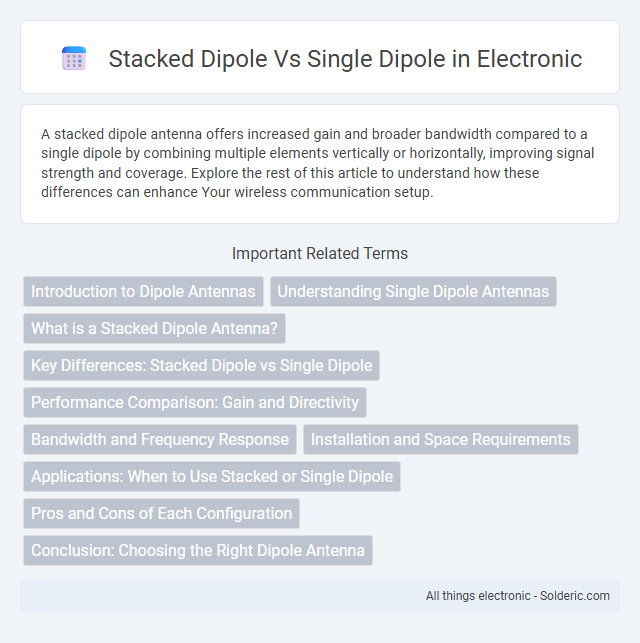A stacked dipole antenna offers increased gain and broader bandwidth compared to a single dipole by combining multiple elements vertically or horizontally, improving signal strength and coverage. Explore the rest of this article to understand how these differences can enhance Your wireless communication setup.
Comparison Table
| Feature | Stacked Dipole | Single Dipole |
|---|---|---|
| Design | Multiple dipoles arranged vertically or horizontally | Single dipole element |
| Gain | Higher gain due to array effect | Moderate gain suitable for basic applications |
| Bandwidth | Broader bandwidth with proper spacing | Narrower bandwidth |
| Directivity | Increased directivity and better signal focus | Lower directivity with wider radiation pattern |
| Size | Larger physical size due to multiple elements | Compact and simple |
| Complexity | More complex feed and tuning required | Simple design and easy to construct |
| Applications | Long-distance communication, high-performance systems | Basic radio receivers, short-range communication |
Introduction to Dipole Antennas
Dipole antennas, fundamental elements in radio frequency transmission, consist of two conductive elements that emit or receive electromagnetic waves. A single dipole antenna provides a basic, omnidirectional radiation pattern, suitable for many communication applications. Stacked dipole arrays, formed by vertically or horizontally aligning multiple dipoles, enhance gain, directivity, and impedance bandwidth, improving performance compared to a single dipole.
Understanding Single Dipole Antennas
Single dipole antennas consist of two conductive elements oriented in a straight line, producing a bidirectional radiation pattern ideal for simple communication setups. They operate efficiently at their resonant frequency, offering a predictable impedance and moderate gain typically around 2.15 dBi. Single dipoles are widely used due to their compact size, ease of construction, and straightforward impedance matching with typical transmission lines.
What is a Stacked Dipole Antenna?
A stacked dipole antenna consists of multiple dipole elements arranged vertically or horizontally to enhance signal strength and bandwidth compared to a single dipole. This configuration improves gain and directivity by combining the radiation patterns of each dipole, resulting in better performance for communications or broadcasting. You benefit from increased range and clearer reception, especially in applications where signal quality is critical.
Key Differences: Stacked Dipole vs Single Dipole
A stacked dipole consists of two or more dipole antennas positioned vertically or horizontally to enhance gain and directivity compared to a single dipole, which operates independently with lower gain. Your choice between stacked and single dipole depends on the need for increased signal strength, improved bandwidth, and reduced interference, as stacked dipoles offer superior performance in these areas. The physical complexity and size of stacked dipole arrays are greater, requiring precise alignment and phasing for optimal operation versus the simplicity and ease of installation of a single dipole.
Performance Comparison: Gain and Directivity
Stacked dipole antennas offer significantly higher gain and improved directivity compared to single dipole antennas by effectively combining multiple elements to reinforce signal strength in a specific direction. This configuration reduces radiation pattern lobes and enhances front-to-back ratio, resulting in better overall performance for long-distance communication and signal clarity. Your system can achieve greater coverage and more focused transmission with a stacked dipole arrangement versus a single dipole setup.
Bandwidth and Frequency Response
Stacked dipole antennas significantly enhance bandwidth by combining multiple dipole elements, resulting in a broader frequency response compared to single dipole antennas. The improved bandwidth accommodates wider signal ranges, reducing the impact of frequency detuning and improving overall antenna performance. Single dipole antennas typically have narrower bandwidth and more limited frequency agility, making them less effective for applications requiring wide or multiple frequency bands.
Installation and Space Requirements
Stacked dipole antennas require more vertical space and precise alignment during installation compared to single dipoles, which are simpler and more compact. The increased size of stacked dipoles offers improved gain and directivity but demands a sturdy mounting structure to support the additional weight. You should consider available space and structural capacity when choosing between a single dipole's ease of setup and the enhanced performance of a stacked configuration.
Applications: When to Use Stacked or Single Dipole
Stacked dipole antennas provide increased gain and improved directivity, making them ideal for long-distance communication and applications requiring strong signal focus, such as TV broadcasting and point-to-point microwave links. Single dipole antennas are preferred for simpler designs, cost-effectiveness, and omnidirectional coverage, commonly used in basic FM radio and mobile devices. Choosing between stacked and single dipoles depends on the need for higher gain and directionality versus simplicity and broad signal reception.
Pros and Cons of Each Configuration
A stacked dipole antenna offers increased gain and improved directivity by combining multiple dipoles vertically, enhancing signal strength and reducing interference, which is advantageous for long-distance communication. However, stacked configurations are more complex, larger, and require precise spacing and phasing, making them less suitable for limited space or simple setups. A single dipole is straightforward, more compact, easy to install, and cost-effective, but it provides lower gain and narrower bandwidth compared to stacked dipole arrays.
Conclusion: Choosing the Right Dipole Antenna
Stacked dipole antennas provide increased gain and improved signal directivity compared to single dipoles, making them ideal for applications requiring enhanced performance and longer range. Single dipole antennas offer simplicity, lower cost, and easier installation, suitable for basic communication needs and compact setups. Selecting the right dipole antenna depends on balancing factors like desired range, signal quality, installation complexity, and budget constraints.
stacked dipole vs single dipole Infographic

 solderic.com
solderic.com